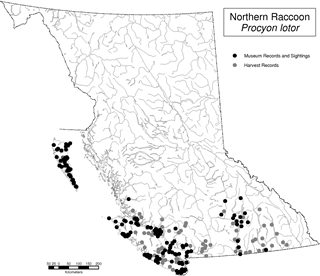The Raccoon is probably one of the most common mammals we see in southern British Columbia. It is a medium-sized mammal 40 to 70 cm in length (Wikipedia 2011) with a distinctive black mask around the eyes, and four to seven dark rings around its tail. It has whitish patches across the forehead and 'eyebrows', and around its muzzle, a long and bushy tail, a black nose-pad, pointed snout, and black ears. Black and white guard hairs give it an overall grayish, grizzled appearance, although some individuals are more brownish in colour. A blonde colour variation is found in BC on islands near Nanaimo (Hatler et al. 2008). The forepaws are very hand-like. Body weight ranges from 3.5 to 9 kg, and males average 10-15% heavier than females (Hatler et al. 2008, Wikipedia 2011).
Two subspecies of Raccoon are recognized in BC, although genetic studies have not yet verified their validity: 1) Procyon lotor pacificus (southern BC) and 2) Procyon lotor vancouverensis (Vancouver Island and adjacent islands) (Hatler et al. 2008).
In 2011, predatory behaviour in a family of raccoons in Richmond, British Columbia was reported, with several incidents of killing and feeding on domestic cats and attacks on dogs.
